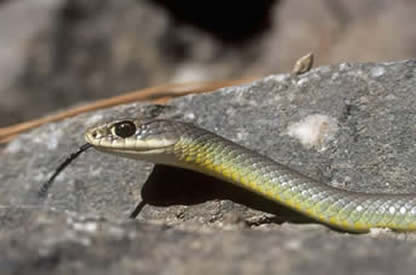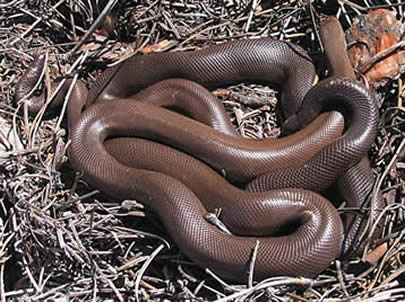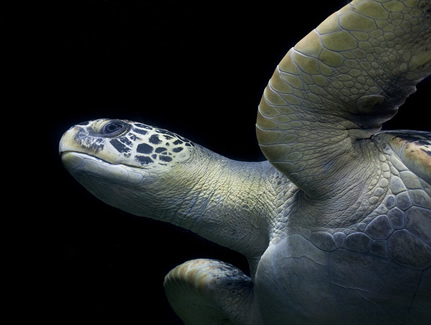

AN INTRODUCTION TO THE REPTILES OF
BRITISH COLUMBIA

Western Yellow-bellied Racer (Coluber constricor mormon),
photo by Dick Cannings
by
British Columbia is often thought of as a place with a damp, cool climate, not where one would expect to find a lot of reptiles. As ectotherms, or "cold-blooded" animals, reptiles are animals that need an external source of heat in order to maintain their body temperatures at levels suitable for bodily functions such as digestion and the development of embryos. However, keeping in mind that parts of the interior of the province are subject to rainshadows, and are contiguous with the reptile-rich desert of the western United States, it should not be surprising that the province has a significant reptile fauna, especially in the valleys of the Southern Interior.
But, before going into more detail, what is a reptile? Traditionally, they have been defined as amniote vertebrates (animals whose embryos are surrounded by an amniotic membrane, and possessing a backbone) that are not mammals or birds. This definition includes turtles, crocodilians, snakes plus lizards and amphisbaenians (collectively known as the squamate reptiles), and the Tuatara from New Zealand These groups are classified together because all are characterized by cold-bloodedness and scaly body coverings, which are primitive features among amniote vertebrates. It is now recognized that to provide natural classifications, which reflect our understanding of evolutionary relationships, groups must be defined by the shared possession of advanced or novel features. In a natural classification, birds would be included within the Reptilia.

Two entwined Rubber Boas (Charina bottae). Photo by Werner Eigelsreiter
Furthermore, recent classifications have removed turtles from the reptiles and placed them in the Class Chelonia (e.g., Collins and Taggart, 2002). Natureserve.org presents Chelonia and Reptilia as separate taxa of equal rank, which assumes that the shared ancestor of turtles and other reptiles is very distant compared to the common ancestor of the other reptiles, including birds, combined. However, it has also been suggested that turtles may be more closely related to crocodilians, than are snakes, lizards and tuataras, making turtles-plus-crocodilians descendents of an earlier evolutionary branch (Zardoya and Meyer, 1998). The important point is that the Class Reptilia as long recognized is not a single natural group that evolved from a single ancestor that is not also the ancestor of animals not considered reptiles .
Although nomenclature and classification have changed, for the sake of clarity, E-Fauna will follow the familiar names for these groups. Therefore, on this page I will discuss the turtles and squamates (lizards and snakes) of B.C., under the heading Reptiles of British Columbia.
Reptiles of British Columbia
British Columbia has relatively few species of reptiles. There are two (formerly three) native turtles, two (until recently, three) native lizards and eight (formerly nine) species of snakes. Long-term, climate-based limiting factors explain this relatively low diversity. Much of the province lacks a long enough warm season to allow ectothermic vertebrates to survive.

Green Turtle (Chelonia mydas). Photo by Brian Klinkenberg
In the few places where there are more than a handful of species, many are considered "peripheral species," those with the major portion of their distribution in the United States. Some of these appear to be in decline as a result of having reached the limits of their climatic tolerances, and may represent artifacts of a desert fauna that arrived with the northward expansion of the Great Basin desert during the warm, dry xerothermic period between 6000 to 4000 BC. As the climate cooled, populations of some of these species became isolated in warm pockets and persisted.
However, it is an important coincidence, in terms of species conservation in British Columbia, that populations of a number of reptilian species only persisted within tens of kilometres of the Canada-U.S. border, where the vast majority of recent human migrants to B.C. have elected to settle. Urban expansion, and conversion of land to agriculture and recreational uses within the historical ranges of peripheral species has led to most peripheral species now being categorized as endangered or otherwise at risk in B.C.
| Common Name | Scientfic Name | |
| Leatherback | Dermochelys coriacea | Northeast Pacific |
| Pacific Pond Turtle | Actinemys marmorata | Extirpated; formerly Coast and Mountains, Georgia Depression |
| Western Painted Turtle | Chrysemys picta bellii | Coast and Mountains, Georgia Depression, Southern Interior, Southern Interior Mountains |
| Red-eared Slider | Trachemys scripta elegans | Coast and Mountains (southern Vancouver Island); Georgia Depression; Southern Interior |
| Northern Alligator Lizard | Elgaria coerulea | Coast and Mountains, Georgia Depression, Southern Interior, Southern Interior Mountains |
| Pigmy Short-horned Lizard | Phrynosoma douglasii douglasii | Extirpated; formerly Southern Interior |
| Western Skink | Eumeces skiltonianus | Southern Interior |
| European Wall Lizard | Podarcis sp | City of Victoria |
| Pacific Gopher Snake | Pituophis catenifer catenifer | Extirpated; formerly Georgia Depression |
| Great Basin Gopher Snake | Pituophis catenifer deserticola | Southern Interior, Central Interior |
| Desert Nightsnake | Hypsiglena torquata | Southern Interior |
| Western Yellow-bellied Racer | Coluber constrictor mormon | Southern Interior, Central Interior |
| Western Rattlesnake | Crotalus oregonus | Southern Interior |
| Sharp--tailed Snake | Contia tenuis | Coast and Mountains (south Vancouver Island; Gulf Islands) |
| Rubber Boa | Charina bottae | Coast and Mountains, Georgia Depression, Southern Interior, Southern Interior Mountains |
| Western Terrestrial Garter Snake | Thamnophis elegans | Coast and Mountains, Georgia Depression , Central Interior, Southern Interior, Boreal Plains, Southern Interior Mountains |
| Northwestern Garter Snake | Thamnophis ordinoides | Coast and Mountains, Georgia Depression |
| Common Garter Snake | Thamnophis sirtalis | Coast and Mountains, Georgia Depression , Central Interior, Southern Interior, Southern Interior Mountains |
The Reptiles of British Columbia
Key References
Andelman, S. J., and E. Gray. 1992. Viability and recovery of western pond turtle (CLEMMYS MARMORATA) populations in Washington state. Abstract, Society for Conservation Biology, 6th Annual Meeting, p. 33.
BC Conservation Data Centre. 2005. BC Species and Ecosystem Explorer. BC Ministry of Environment, Victoria BC. Available: http://srmapps.gov.bc.ca/apps/eswp/ (accessed 13 January 2006).
Cameron, M.A. & R. St. Clair. 1999. COSEWIC Status Report on the Pacific Pond Turtle Clemmys marmorata. Committee on the Status of Endangered Wildlife in Canada (COSEWIC), Ottawa, Ontario.
Cameron, M.A. and R. St. Clair. 2002. COSEWIC Assessment and Status Report on the Pacific Pond Turtle Clemmys marmorata in Canada.
Cameron, M. & R. St. Clair. 2003. COSEWIC Status report on the rubber boa Charina bottae. Preliminary 2-month Interim Report. Prepared for the Committee on the Status of Endangered Wildlife in Canada (COSEWIC), Ottawa, Ontario.
Campbell, C.A. & D.W. Perrin. 1997. Status report on the racer Coluber constrictor in Canada. Committee on the Status of Endangered Wildlife in Canada (COSEWIC), Ottawa, Ontario.
Cannings, S.G., L.R. Ramsay, D.F. Fraser, & M.A. Fraker. 1999. Rare amphibians, reptiles, and mammals of British Columbia. Wildlife Branch and Resource Inventory Branch, B.C. Ministry of Environment, Lands, and Parks, Victoria, British Columbia, http://wlapwww.gov.bc.ca/wld/documents/spsum.
Collins, J.T. and T.W. Taggart. 2002. Standard Common and Current Scientific Names for North American Amphibians, Turtles, Reptiles and Crocodilians. 5th Edition. Center for North American Herpetology, Lawrence Kansas. iv + 44 pp.
Charland, M.B., K.J. Nelson and P.T. Gregory. 1993. Status of the Northern Pacific Rattlesnake in British Columbia. Wildlife Working Report No. WR-54. British Columbia Ministry of Environment. 27pp.
Cook, F.R. 1984. Introduction to Canadian Amphibians & Reptiles. National Museum of Natural Sciences, Ottawa, Ontario. ISBN 0-660-10755-4.
Christian, K.A. 1998. Thermoregulation by the short-horned lizard (Phrynosoma douglassi) at high elevation. Journal of Thermal Biology 23: 395-399.
Crim, J.L., L.D. Spotila, J.R. Spotila, M. O’Connor, R. Reina, C.J. Williams, & F.V. Paladino. 2002. The leatherback turtle, Dermochelys coriacea, exhibits both polyandry and polygyny. Molecular Ecology 11: 2097-2106.
Didiuk, A.B., J.M. Macartney, & L.A. Gregory. 2003. Status report on the Northern Pacific rattlesnake Crotalus oreganus oreganus (Holbrook) in British Columbia. Draft. Prepared for the Committee on the Status of Endangered Wildlife In Canada (COSEWIC), Ottawa, Ontario.
Gray, E.M. 1995. DNA fingerprinting reveals a lack of genetic variation in northern populations of the western pond turtle (Clemmys marmorata). Conservation Biology 9: 1244-1254.
Gregory, P.T. 1984. Habitat, diet, and composition of assemblages of garter snakes (Thamnophis) at eight sites on Vancouver Island. Canadian Journal of Zoology 62: 2013-2022.
Gregory, L. 2001. COSEWIC status report on the night snake, Hypsiglena torquata. Prepared for the Committee on the Status of Endangered Wildlife in Canada (COSEWIC), Ottawa, Ontario.
Gregory, P.T. and R.W. Campbell. 1984. The Reptiles of British Columbia. RBCM Handbook. 112 pp.
Lacey, H., C.H. Shewchuk, P.T. Gregory, M.J. Sarell, & L.A. Gregory. 1996. The occurrence of the night snake, Hypiglena torquata, in British Columbia, with comments on its body size and diet. Canadian Field-Naturalist 110: 620-625.
Larsen, K.W. & P.T. Gregory. 1989. Population size and survivorship of the common garter snake, Thammophis sirtalis, near the northern limit of its distribution. Holarctic Ecology 12: 81-86.
Larsen, K.W., P.T. Gregory and R. Antoniak. 1993. Reproductive ecology of the common garter snake Thamnophis sirtalis at the northern limit of its range. American Midland Naturalist 129: 336-345.
McAlpine, D.F., S.A. Orchard, & K.A. Sendall. 2002. Recent occurrences of the green turtle from British Columbia waters. Northwest science 76: 185-188.
Nelson, K.J. 1992. A survey of the distribution, biology, and population trends of the Great basin gopher snake, Pituophis melanoleucus deserticola, in British Columbia. In consultation with P.T. Gregory, University of Victoria, Victoria, British Columbia.
Nield, D. 2002. Recovery strategy for the Great Basin Gopher Snake (Pituophis catenifer ssp. deserticola). Prepared by D. Nield and the Herpetological Conservation Action Group for the Ministry of Water, Land, and Air Protection, Central Interior of British Columbia.
Nussbaum, R.A., E.D. Brodie Jr. & R.M. Storm. 1983. Amphibians & Reptiles of the Pacific Northwest. University of Idaho Press. Moscow, Idaho. ISBN 0-89301-086-3.
Ovaska, K.E. & C. Engelstoft. ? Status report on the sharp-tailed snake Contia tenuis Baird and Girard, in Canada. Draft. Prepared for the Committee on the Status of Endangered Wildlife in Canada (COSEWIC), Ottawa, Ontario.
Ovaska, K. and C. Engelstoft. 2002. COSEWIC Report on the Status of the Western Skink Eumeces skiltonianus in Canada.
Ovaska, K., L. Sopuck, C. Engelstoft, L.Matthias, E.Wind and J. MacGarvie. 2003. Best Management Practices for Amphibians and Reptiles in Urban and Rural Environments in British Columbia. B. C. Ministry of Water Air and Land Protection. 151pp.
Powell, G.L., and A.P. Russell. 1992. Status report on the Short-horned Lizard, Phrynosoma douglassi, in Canada. Submitted to the Committee. on the Status of Endangered Wildlife in Canada, Ottawa.
Powell, G.L. & A.P. Russell. 1998. The status of short-horned lizards, Phrynosoma douglasi and P. hernandezi, in Canada. Canadian Field-Naturalist 112: 1-16.
Rodriguez-Robles, J.A. D.G. Mulcahy, & H.W. Greene. 1999. Feeding ecology of the desert night snake, Hypsiglena torquata (Colubridae). Copeia 1999:93-100.
Rutherford, P.L. and P.T. Gregory. 2003. Habitat use and movement patterns of Northern Alligator Lizards (Elgaria coerulea) and Western Skinks (Eumeces skiltonianus) in Southeastern British Columbia. Journal of Herpetology 37: 98-106.
Sarell, M.J. 2003. Recovery strategy for the Pigmy Short-horned Lizard (Phrynosoma douglasi) in Canada. First Draft. Prepared for the Southern Interior Reptile and Amphibian Recovery Team in British Columbia.
Shewchuk, C.H. & H.L Waye. 1995. Status of the western yellow-bellied racer in British Columbia.
Spotila, J.R., R.D. Reina, A.C. Steyermark, P.T. Plotkin, & F.V. Paladino. 2000. Pacific leatherback turtles face extinction. Nature 405:529-530.
St. Clair, R.C. & P.T. Gregory. 1990. Factors affecting the northern range limit of painted turtles (Chrysemys picta) – winter acidosis or freezing. Copeia 1990: 1083-1089.
St. John, A. 2002. Reptiles of the Northwest, British Columbia to California. Lone Pine Publishing, Edmonton, Alberta. ISBN 1-55105-343-8.
Waye, H.L. & C. Shewchuk. 1999. COSEWIC Status Report on the Gopher Snake Pitouphis catenifer. Prepared for the Committee on the Status of Endangered Wildlife (COSEWIC) in Canada, Ottawa, Ontario.
Zardoya, R. and A. Meyer. 1998. Complete mitochondrial genome suggests diapsid affinities of turtles. Proceedings of he National Academy of Sciences 95: 14226-14231.
Please cite these pages as:
Author, date, page title. In: Klinkenberg, Brian. (Editor) 2021. E-Fauna BC: Electronic Atlas of the Fauna of British Columbia [www.efauna.bc.ca]. Lab for Advanced Spatial Analysis, Department of Geography, University of British Columbia, Vancouver. [Date Accessed]
© Copyright 2021 E-Fauna BC.